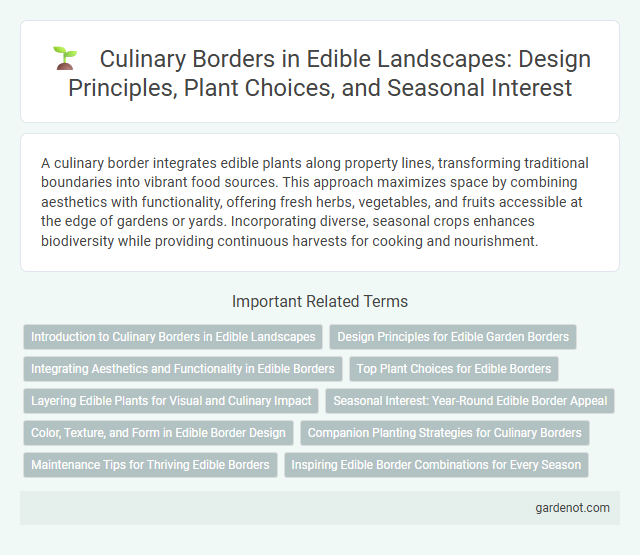A culinary border integrates edible plants along property lines, transforming traditional boundaries into vibrant food sources. This approach maximizes space by combining aesthetics with functionality, offering fresh herbs, vegetables, and fruits accessible at the edge of gardens or yards. Incorporating diverse, seasonal crops enhances biodiversity while providing continuous harvests for cooking and nourishment.
Introduction to Culinary Borders in Edible Landscapes
Culinary borders in edible landscapes blend functional gardening with aesthetic design, integrating herbs, vegetables, and edible flowers along garden edges to create both visual appeal and convenient access to fresh ingredients. These borders not only enhance biodiversity and attract pollinators but also transform traditional garden perimeters into productive, flavorful spaces. Incorporating culinary borders encourages sustainable food practices and fosters a deeper connection between gardeners and their harvest.
Design Principles for Edible Garden Borders
Culinary border design principles emphasize plant selection, spatial arrangement, and aesthetic harmony to create functional and visually appealing edible garden borders. Incorporating herbs such as rosemary, thyme, and basil alongside low-growing vegetables enhances both usability and texture contrast. Strategic layering and color coordination optimize growth conditions and harvest efficiency while defining garden boundaries.
Integrating Aesthetics and Functionality in Edible Borders
Edible landscapes transform culinary borders into vibrant, sustainable features that merge aesthetics with functionality by incorporating herbs, vegetables, and flowering plants along garden edges. These multifunctional borders not only provide fresh, organic ingredients but also enhance biodiversity, attract pollinators, and create visually appealing transitions between spaces. Selecting plants like lavender, thyme, and kale ensures year-round harvests while maintaining structural beauty and ecological benefits in edible landscapes.
Top Plant Choices for Edible Borders
Top plant choices for edible borders include herbs like rosemary, thyme, and sage, which provide aromatic flavors and drought tolerance. Berry bushes such as blueberries and raspberries offer vibrant color and nutritious fruit, enhancing both aesthetics and harvest. Perennial vegetables like kale and chard create lush greenery while delivering continuous edible yields throughout the growing season.
Layering Edible Plants for Visual and Culinary Impact
Layering edible plants in an edible landscape enhances both visual appeal and culinary diversity by combining textures, colors, and flavors at varying heights. Incorporate ground covers like herbs, mid-height vegetables such as lettuces, and taller plants like fruit trees to create a dynamic and productive garden space. This strategic layering maximizes space efficiency, supports plant health through microclimate creation, and provides a continuous harvest for kitchen use.
Seasonal Interest: Year-Round Edible Border Appeal
A culinary border designed for seasonal interest combines a variety of edible plants that thrive throughout the year, ensuring continuous harvest and visual appeal. Incorporating hardy herbs like rosemary and thyme with annual vegetables such as kale and radishes extends productivity across all seasons. Strategically planting fruiting shrubs like blueberries alongside edible flowers boosts biodiversity while enhancing the border's vibrant, year-round aesthetic.
Color, Texture, and Form in Edible Border Design
Culinary borders incorporate vibrant colors, diverse textures, and unique forms to create visually appealing and functional edible landscapes. Plants like purple basil, variegated chard, and fragrant herbs provide contrasting hues and tactile variety, enhancing both sensory and gastronomic experiences. Strategic layering of leaf shapes and flower structures adds dimensionality, transforming edible borders into dynamic, multi-sensory garden features.
Companion Planting Strategies for Culinary Borders
Companion planting strategies in culinary borders enhance plant growth and flavor by pairing herbs and vegetables that benefit each other, such as basil with tomatoes to improve taste and deter pests. Strategic planting of aromatic herbs like rosemary and thyme alongside vegetables can naturally repel harmful insects, reducing the need for chemical interventions. Incorporating nitrogen-fixing plants like beans within culinary borders enriches soil fertility, promoting healthier, more robust crops for a sustainable edible landscape.
Maintenance Tips for Thriving Edible Borders
Regular watering and mulching are essential for maintaining a thriving culinary edible border, ensuring consistent soil moisture and nutrient retention. Pruning herbs like rosemary, thyme, and oregano encourages dense growth and prevents woody stems, while removing spent flowers promotes continuous harvest. Integrated pest management techniques, such as introducing beneficial insects and using organic deterrents, protect plants from common pests without harmful chemicals.
Inspiring Edible Border Combinations for Every Season
Create culinary borders using a variety of herbs, vegetables, and edible flowers to provide vibrant colors and flavors throughout the year. Combine perennial greens like rosemary and thyme with seasonal additions such as cherry tomatoes in summer and kale in winter for continuous harvest. Incorporating pollinator-friendly plants like lavender and nasturtium enhances biodiversity while offering dynamic taste and visual appeal.
Culinary border Infographic

 gardenot.com
gardenot.com